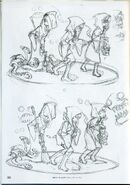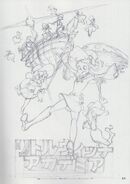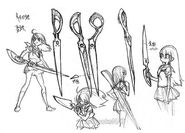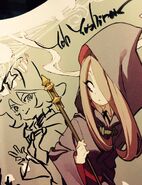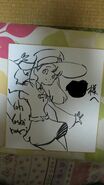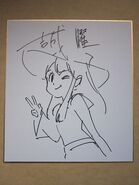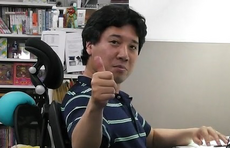
Yō Yoshinari (吉成 曜 Yoshinari Yō), born May 6, 1971, is a Japanese key animator, storyboard artist and anime director. He is known for his exaggerated style of his effects animation, mainly for smoke and explosions. He is the concept creator for Little Witch Academia and has worked on other anime series such as Kill la Kill, Gurren Lagann, and Neon Genesis Evangelion. On the original short film Little Witch Academia, he served as director, character designer, animation director, and drew background roughs.[1]
He was the director for the Little Witch Academia initial short film, the Little Witch Academia: The Enchanted Parade sequel film, and the Little Witch Academia animated TV series.
Up until Michiru Shimada's passing, Yoshinari revealed during AnimeExpo 2017's Studio TRIGGER panel and interviews that he had plans for sequel where it will focus more on other witches such as Amanda, Constanze, and Jasminka, or spin-off focusing on Chariot's backstory and Night Fall.[2][3][4][5] During Shin Bungeiza X AnimeStyle Vol. 167 events which involves a talk show with Yoshinari and his fellow animators in addition of screenings of animes such as original short, The Enchanted Parade, and Gridman Universe, Yoshinari himself revealed his plan to make Little Witch Academia a long-running series as much as Nintama Rantarō.[6][7]
Personal life[]
Yō Yoshinari was born in Tokyo, Japan. He is the younger brother of Kō Yoshinari, who is also an key animator. Yoshinari graduated from Tokyo Designer Gakuin College and entered the anime industry through the influence of his older brother. In his time as Kō's assistant, the brothers learned many things such as how to draw douga. After graduating at high school, he went to work as a pro before entering professional school and subsequently joining a studio. It was during his time at professional school that Yoshinari noticed anime to be more polished[1].
He joined Madhouse in 1992, then left in the same year and joined Gainax, where he worked until 2011 when he joined Imaishi and other ex-Gainax employees to form Studio Trigger.
When looking back at the time he joined Madhouse, he admitted to have sent some applications to Gainax also but the latter responded very much late (3 months later) due to an implied misunderstanding among Gainax staff. Not wanting to explain, Yoshinari told Madhouse "being an animator is too hard for me, so I quit", and switched to Gainax. Prior to entering professional school and joining a studio, he worked as an uncredited pro helping his older brother in several early works, with his first being doing in-betweens and keys on the 1991 OVA Bousou Sangokushi: Specter Tanjou during high school[1].
When joining Gainax on the other hand, Yoshinari was dismayed to see not many people around his age have proper knowledge about animators, which didn't help by the decline of interest in anime industry, leading to "ice age of talents" as Hiroyuki Imaishi also put it. In fact, not many people with great talent in such industry being around their age unlike previous generations and the period for things like Project A-ko where general atmosphere being everything had to be done came to a close. Still, new animation styles in courtesy of the likes of Satoru Utsunomiya, Masaaki Yuasa, Shinya Ohira came out, and Yoshinari implied his reason of joining anime industry being influenced by The Hakkenden while 'wandering around' in it instead of ambition[1].
Throughout his career, Yoshinari found himself often, if not always, in charge of actions/effects of difficult scenes despite eager for other endeavors such as acting. He admitted doing so more out of fun instead of mastering action animation outright, but nevertheless put both the work and audience's enjoyment into consideration to make it enjoyable for everyone equally[1].
During the development of original short of Little Witch Academia as part of 2013 Anime Mirai, contrary to some people assumption of it being retelling of Harry Potter series as with other fantasy works with magic school settings, Yoshinari confirmed it to be original work as its plot being in line with Anime Mirai's purpose in raising young animators (he even mentioned the film's initial idea revolving a wizard's apprentice which unfortunately, won't likely work like they hoped to be). To further drive this point, the theme of the film was a young animator who joined anime industry looking up to a late-night magical girl anime only to be ridiculed by people around him — a hardship which paralleled not just Akko's own who inspired by Shiny Chariot who perceived as maverick in the eyes of older, proud traditionalistic magical families, but also how Hayao Miyazaki inspired by Panda and the Magic Serpent. In all cases, admiration is important. As the short film's director, he was in charge of supervising the whole story while creating the general imagery in addition of coaching the younger staff. Yoshinari admitted the endeavor took so much time because he's admittedly still a learner as much as them. Despite having clear aspirations for entertainment, Yoshinari required Hiroyuki Imaishi's guidance in ensuring his works executed properly[8].
Yoshinari was content in contributing on series he and his peers developed in any way he could in addition of drawing and animation, which perhaps attributed to reality of anime industry lacked many talented people, especially concerning Hiroyuki Imaishi's works which he admitted to be quite special. Having worked with the latter all the time just as Mahiro Maeda with Hideaki Anno, Yoshinari acknowledged Hiroyuki Imaishi to have exuberant imagination and make good use of others' ideas despite not many ended up realized yet at the same time often came up with rough drawings which challenging to transcribe. As such, throughout their collaboration, he felt more useful in making designs that simply doing animation on special cuts[8].
When it comes about works that set in real-life locations such as Tokyo, Yoshinari believes that realism is important in them; it's imperative to accurately show said works take place there, even as far as their art director go.[9]
Animation Style and influences[]
| “ | ” | |
—Hiroyuki Imaishi explained the greatness of "Yoshinari sakuga"[1] | ||
In Imaishi's admission, he found Yoshinari to be "sharp", often using a ruler while working on mecha animations hence their sharper and more rigid feel despite his peers at Gainax no longer using such approach, at least until the development of Jin-Roh where he started softer forms. Yoshinari attempted to pour everything he took notes from best animations he had seen in the one he worked on. The tough development of spectacular animation style Yoshinari currently best known at also attributed to his past preference to draw realistic, plaster figure-like shapes and accurate movement which contrasted to his mentor Kazuya Tsurumaki's typical anime-ish rhythm and energy. Although he had less and less time to draw key frames since his and Imaishi's collaboration in Tengen Toppa Gurren Lagann, it didn't prevent his drawings to be less dense, let alone unable to finish them in time. In fact, there were instances of him drawing more than what he needed, mostly key frames depicting very detailed explosion cuts. Overall, Yoshinari served as the 'trigger' for Hiroyuki Imaishi in deciding his would-be career in animation industry, more so with him getting invested with directing and screenwriting to improve himself[1].
Yoshinari didn't deny of his works being described as a "bundle" (condensing every kind of coolness in one style) by Imaishi, though he admitted there's more than that. He believed in importance of being open-minded so as not to develop biased tastes, having taken notes on not just from Yoshinori Kanada and Yoshikazu Yasuhiko's styles, but also those of other various works to improve his own, animation from foreign countries included[1].
Yoshinari admitted not to have any inclination or particular preference to certain drawing style, understanding that each one has different approaches/aesthetics and at the same time open to others' suggestions in revising his designs should they fail to meet their expectations. Although he initially sticked to the style he get used it while working as his brother's assistant, Yoshinari eventually had to develop his own upon joining Gainax because their approaches contrasted one another[1].
Yoshinari is recognized for action cuts with dense movement and composition, which are termed "Yoshinari cuts", though it was developed from habit instead of ideal form as he wanted to try different things. Still, he hasn't experimented so much after FLCL from losing pursuing spirit and even stopped putting his key frames to see how they moved — a contrast to how he usually checked how his key animation worked when he was younger. Although, he admitted to be afraid of not checking on new kind of key frames he never made prior.[10]. Additonally, he is also well known for his very detailed explosion cuts[1][11], along with the way he represents volume and perspective using spheres[10].
Yoshinari had disclosed various influences he drew inspirations from throughout his career, such as Ikuto Yamashita and Takeshi Honda for his use of forms; The manga Nijitte Monogatari as one of his most important influeces when it comes to drawing; Yoshinori Kanada and Shinya Ohira for movements; Satomi Kamie for manga, Egon Schiele for paintings and Mike Mignola for American comics. This also included Yasuomi Umetsu and Nobuteru Yuki, in which he acknowledged the endeavor of perfectly replicating the former's works demanded extensive preparations which included careful observation due to how difficult it was. The latter's style also similarly challenging that he was uncertain whether to be able to draw on his level. He remembered how most of past animators in 1980s ended up taking notes from Masahito Yamashita instead of Yoshinori Kanada whom they thought to be copied of, hence lacked the same sharpness as the latter. As Kanada's approach in animation changed, aforementioned animators followed Yamashita more due to the latter's more impactful style that focused on rhythm in addition of movement, which Yoshinari described as "ideal form". Yoshinari is also familiar with Hiroyuki Okiura whose style become more and more elaborate yet not underwent metamorphosis like Iso's for aiming to reach pinnacle by only elevating the pre-existing technique[10].
While working on his animations, Yoshinari is the one who made vague plans when inclined to do so instead of planning things meticulously. Nevertheless he ensured them to be at least less objectionable than the last[8].
When it comes about works whose comedy being very heightened, over the top, and scandalous such as Panty & Stocking with Garterbelt, Yoshinari admitted in an interview that he relied on Imaishi's guidance to make sure it won't be too extreme, though the latter admitted they won't hold back if works in question will be aired in the likes of Adult Swim.[12]
Other notable works[]
- Boukyaku no Senritsu (mechanical Design)
- Bousou Sengokushi: Specter Tanjou (uncredited)[1]
- Chou Kidou Densetsu DinaGiga (key animation, opening)
- Dead Leaves (key animator)
- Gunbuster 2: Diebuster (OAV)[1] (Key Animation, episodes 1-5)[13]
- Gunbuster vs Diebuster Aim for the Top! The GATTAI!! Movie (Key Animation)
- Gurren Lagann Parallel Works (director, animation director, storyboard artist, key animator, episode 8)
- Mahoromatic - Automatic Maiden (TV) (Key Animation, episodes 1, 4, 9, 11)
- Mahoromatic: I'm Home! (special) Guest Mecha Design, Key Animation (ep 2)
- Mahoromatic: Something More Beautiful (TV) Animation Cooperation (ep 11), Key Animation (OP; eps 1, 10, 13)
- Mahoromatic: Summer Special Key Animation
- Medabots (key animator)
- Mobile Suit Victory Gundam (key animation, episodes 35, 39, 44, 51)
- Panty & Stocking with Garterbelt (concept art, animation director, key animation, episode 12B)
Trivia[]
- Yoshinari was chosen to be the director of the original Little Witch Academia short because he was free and therefore readily available when the roles were assigned. He was delighted upon learning it being integrated into Anime Mirai hence its more flexible production schedule than works intended for TV broadcast[14][15].
- Although having little to no involvement in the Kickstarter held for The Enchanted Parade movie and that Studio Trigger attempted to try something new at the time, Yoshinari nevertheless confessed his pleasant surprise upon positive feedback it received which made the film greenlit.[16]
- According to Yoshinari, if a second season or sequel to TV Series adaptation of Little Witch Academia eventually greenlit, he wanted to explore more about Jasminka's background, more slapstick of daily life-centered episodes, and expanding the lore about magic in the franchise.[17]
- The following are things Yoshinari regretted not doing back during the development of anime TV Series, as stated during Trigger Night Vol. 6[18][19]:
- More screentime for Hannah, Barbara, Jasminka, and Avery.
- How Akko's parents reacted upon seeing her and Diana's final battle against Noir Rod-infested missile.
- Yoshinari's favorite manga is Nijitte Monogatari, which is remarked as one of the most important influences in his drawing style[10].
- Kazuo Koike's content is one of Yoshinari's influences for story[10].
- According to Yō Yoshinari, his top 3 animators as of 2013 are Hiroyuki Okiura, Shinya Ohira, and Mitsuo Iso[10].
- In an interview, Yoshinari admitted himself to be the one who can immediately appreciate anything instead of just drawing and content of correctly handling the works he get[8].
- Yoshinari was inspired by Mobile Suit Gundam franchise. He also used to read various works of Fujiko F. Fujio such as Doraemon. He is also no stranger to Bande dessinée, comic book company which famous for various series such as Lucky Luke, which he sees the work of animators in general close to in terms of relationship with drawing[9].
- Yoshinari believes that manga and anime creators have different roles. To elaborate, the former is a very individual process while the latter a collective effort where animators have the task to focus only on the drawing[9].
- Yoshinari's interest in anime in general leans more to storytelling than characters features as most of characters in question represent archetypes one won't likely encounter in real life[9].
- The differences between Japanese and Western animations, as Yoshinari put it: "First of all, animators need to draw so many pictures, so many sheets, that they are required to simplify the drawings. Animation is a western invention, and when watching American cartoons, they are constantly moving; they use so many sheets of drawings. Outside Japan, animation is often done at 24 frames per second. That’s different from Japanese animation, where we use less of them because of the time and budget constraints. This explains why in anime, even still scenes are considered essential and bear a lot of meaning. In my opinion, Japanese animation’s particularity was born from having to concentrate the meaning in a few frames. Japanese animation did not seek to be realistic and was very inspired by Disney. Osamu Tezuka, the pioneer of Manga was influenced by Disney. One may say that the source of Japanese animation is Disney. But even though the origin is found in Disney, we did not have the same resources, so each picture needed to bear a lot more meaning. That’s how Japanese animation took the path it did. It wasn’t a direct evolution but more of a deviation with some circumvolution."[9]
- Thanks to his remarkable talent in drawing as showcased back during the production of Gurren Lagann or Kill la Kill, Yoshinari earned the nickname of "The Dreams Factory"[9].
- Yoshinari is no stranger to the fact that anime studios in general, Studio Trigger included, operate 24 hours and not comfortable in discussing their staff's working conditions as the result. He does however hopes some improvements in them and used to working on a series all night while resting during the day[9].
- As of 2018, Yoshinari's residence is situated at rural regions of Tokyo[9].
- When designing the female cosplayer featured in the poster of Japonisme 2018 Official Project MANGA TOKYO Exhibition (see the poster in gallery below), M. Kaichiro Morikawa, Shigeto Koyama, Yoh Yoshinari, and Tsuyoshi Kusano ensured her not to show too much personality and neither actual main character nor heroine thus more of a side character hence why she wears glasses. Yoshinari acknowledged the endeavor to be challenging since they worked on characters who serve as their respective franchise's mascot of sort[9].
- When talking about the beginnings of the collaboration between Studio Trigger and Netflix, Yoshinari described their circumstances to be like this: "Netflix did not have any specific requests, but it’s probably because it was at the very beginning of their activities within anime. Now they had time to analyze the trends and what kind of works audiences are expecting and are thriving. Netflix is very sensitive to trends. They have started making requests following these trends. Because they had time now to spot what shows are successful or not, there is now less freedom."[9]
Gallery[]
Various artworks[]
[]
Others[]
Production materials[]
Sketches[]
Miscellaneous[]
Videos[]
References[]
- ↑ 1.00 1.01 1.02 1.03 1.04 1.05 1.06 1.07 1.08 1.09 1.10 1.11 YOH YOSHINARI INTERVIEW (ANIMESTYLE, 03/2013) PART 1/3
- ↑ Trigger Panel in YouTube (time: 25:30)
- ↑ http://www.inquisitr.com/4343044/little-witch-academia-season-2-release-date-on-netflix-episode-14-25-director-lwa-season-3-characters-akko-anime-news/
- ↑ Little Witch Academia Director Wants to Do Another Season, Spinoff (Archive) | Japanese source (yaron-blog)
- ↑ 『リトルウィッチアカデミア』 監督「やりたいことが多すぎて2クールじゃ全く足りない」「シャリオのスピンオフアニメも作りたい」 (archived)
- ↑ https://twitter.com/Up_LWA/status/1728287886859173889
- ↑ https://twitter.com/manbavarang1/status/1729135450273784246
- ↑ 8.0 8.1 8.2 8.3 YOH YOSHINARI INTERVIEW (ANIMESTYLE, 03/2013) PART 3/3
- ↑ 9.0 9.1 9.2 9.3 9.4 9.5 9.6 9.7 9.8 9.9 https://fullfrontal.moe/manga-tokyo-exhibition-panel/
- ↑ 10.0 10.1 10.2 10.3 10.4 10.5 YOH YOSHINARI INTERVIEW (ANIMESTYLE, 03/2013) PART 2/3
- ↑ EPISODIC GURREN LAGANN INTERVIEWS WITH DIRECTOR HIROYUKI IMIASHI & CO. – EPISODE 1 (ANIME STYLE, JANUARY 2008)
- ↑ https://www.animenewsnetwork.com/feature/2015-08-06/interview-studio-trigger/.91296
- ↑ https://www.animenewsnetwork.com/encyclopedia/people.php?id=3702
- ↑ ZOOM SUR ... LITTLE WITCH ACADEMIA
- ↑ English translation of Studio Trigger Fr Interview 3
- ↑ https://www.animenewsnetwork.com/feature/2015-08-06/interview-studio-trigger/.91296
- ↑ https://web.archive.org/web/20220108110331/https://twitter.com/poriyama_san/status/888741616759865344
- ↑ https://twitter.com/sana0827/status/895321475774783488
- ↑ https://togetter.com/li/1138777
External links[]
 You Yoshinari
You Yoshinari Yō Yoshinari
Yō Yoshinari- Yō Yoshinari at Anime Matsuri site (archived in May 20, 2015)
Interviews[]
- Anime News Network
- Interview: Studio Trigger by Jacob Chapman August 6, 2015
- Ani-Gamers
- Full Frontal
- Manga.Tokyo
- TV Anime ‘Little Witch Academia’: Interview with Director Yoh Yoshinari by manga.tokyo January 21, 2017 (Archive link on March 19, 2021)
- Japanese source (Anime!Anime!) - TVアニメ「リトルウィッチアカデミア」吉成曜監督インタビュー TRIGGERはこういうアニメもできるんだと見せたかった December 26, 2016
- TV Anime ‘Little Witch Academia’: Interview with Director Yoh Yoshinari by manga.tokyo January 21, 2017 (Archive link on March 19, 2021)
- Otaku News
- An Interview with Little Witch Academia Creators by Joe November 6, 2017
- Studio Trigger.com
- Focus on Little Witch Academia by Otaking April 29, 2013 (Archived on June 4, 2019) | English translation
- Wave Motion Cannon
- YOH YOSHINARI INTERVIEW (ANIMESTYLE, 03/2013) PART 1/3 by NohAcro and Josh Dunham December 19, 2016
- YOH YOSHINARI INTERVIEW (ANIMESTYLE, 03/2013) PART 2/3 by NohAcro and Josh Dunham December 27, 2016
- YOH YOSHINARI INTERVIEW (ANIMESTYLE, 03/2013) PART 3/3 by NohAcro and Josh Dunham January 3, 2017
- LITTLE WITCH ACADEMIA: INTERVIEW WITH DIRECTOR YOH YOSHINARI by NohAcro and Josh Dunham February 15, 2017
News[]
- Anime News Network
- Anime Matsuri
- Little Witch Academia 2 coming to Anime Matsuri by John Leigh September 25, 2014
- Bakugai
- The Art of Yoh Yoshinari – Illustrations by Humpty Dumpty December 11, 2017
- Otaku Magazine USA
- Little Witch Academia Director Wants to Do Another Season, Spinoff by Matt Schley March 6, 2017
- Japanese source (yaron-blog) - 『リトルウィッチアカデミア』 監督「やりたいことが多すぎて2クールじゃ全く足りない」「シャリオのスピンオフアニメも作りたい」 March 5, 2017
- Little Witch Academia Director Wants to Do Another Season, Spinoff by Matt Schley March 6, 2017
- Probably About Anime
- Yoh Yoshinari: A Living Legend of Animation by Michael Hendricks June 7, 2020
- Sobre animadores y sakuga
- Yoh Yoshinari by ashita01 October 22, 2015








